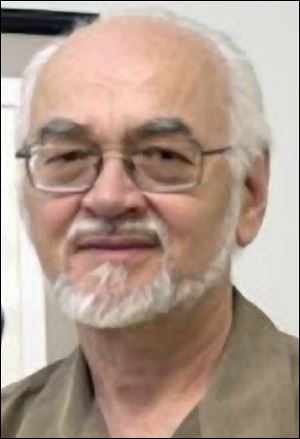
Jaak Panksepp (1943-2017): BGSU researcher recognized for work with emotions, brain
4/20/2017BOWLING GREEN — Jaak Panksepp, whose scientific research at Bowling Green State University into the brain, behavior, and emotion won global attention, none so much as the finding that lab rats, when tickled, laugh, died Tuesday in his Bowling Green home. He was 73.
He learned in November he had squamous cell carcinoma, his wife, Anesa Miller, said. A book he co-wrote on the neuroscience of personality is to be published soon, she said. He continued his research through February.

Panksepp
“He was still going to campus, even when he had to walk on crutches because he had a lot of pain,” his wife said.
Mr. Panksepp was a BGSU distinguished research professor emeritus. At his death, he held an endowed chair in animal well-being science at Washington State University, where he was a professor in the college of veterinary medicine.
Not long before he retired from BGSU, a postdoctoral student suggested recording laboratory rats, the better to hear their sounds at play. Special equipment to detect high-pitched sound was set up.
“And, lo and behold,” Mr. Panksepp told The Blade in 1998, “it sounded like a playground!”
He later thought of prompting rat vocal response by tickling the rodents.
“As soon as we did it, it was — Eureka!” he said then, adding that he was fully aware that others might question the worth of such research. In a later stage of the work, he said that his search for the neural circuitry and genes for laughter were a study of “the biology of joy.”
Some scientific journals balked at publishing the research, “because he called it a corollary to human laughter,” his wife said. People Magazine and News of the Weird wrote about it.
“He was a very passionate person and had a great curiosity and was passionate to explore his curiosity,” his wife said. “He was very excited about trying to make a contribution to mental health and human understanding.”
Mr. Panksepp arrived at BGSU in 1972, and early on received attention for his research on how the brain influences the desire for food, drink, and sleep. He later was recognized for work on autism and attention deficit-hyperactivity disorder.
“In my research, I try to understand how the brain organizes emotional and motivational processes,” Mr. Panksepp said in 1988 as he was named BGSU’s second distinguished research professor. The Northwest Ohio Society for Autistic Children named him “professional of the year” in December, 1991.
He was born June 5, 1943, in Tartu, Estonia, to Salme and Rudolph Panksepp. The family fled the next year to escape the Soviet Army, his wife said.
“That loss colored his early life and the anger from people of his parents’ generation made such an impression on him that he became curious about emotions and how these powerful forces drive human beings to do the most mind-boggling things,” his wife said. “He said many times just because something we might call human nature is based in biology, that doesn’t mean that we cannot change it, manage it, direct it in positive ways.”
After several years as displaced persons, they found a sponsor and were able to move to the United States. He grew up in Delaware and, by his mid-teens, Lakewood, N.J., his wife said.
He received a bachelor’s degree from the University of Pittsburgh and a master’s degree and doctorate from the University of Massachusetts.
For his life’s work, he received the Order of the White Star from the president of Estonia.
His daughter, Tiina Panksepp, died in 1991.
Surviving are his wife, Anesa Miller; son, Jules Panksepp; stepdaughters Antonia Pogacar and Ruth Pogacar-Kouril, and a step-granddaughter.
Memorial services will be at 4 p.m. Friday in Prout Chapel on the BGSU campus. Arrangements are by the Deck-Hanneman Funeral Home, Bowling Green.
The family suggests tributes to the J.P. Scott Center for Neuroscience, Mind & Behavior in care of the BGSU Foundation.
Contact Mark Zaborney at: mzaborney@theblade.com or 419-724-6182.